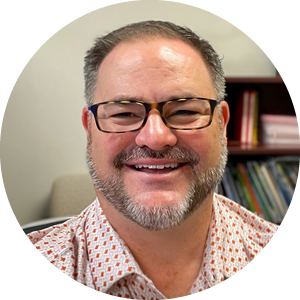
When R. Wade Wilshusen’s coaching budget was cut in half, he and his team had to go back to the drawing board. Wilshusen is an elementary instructional coach facilitator. Normally, coaches are paired with teachers based on expertise. For example, a coach who understands math well would work with a math teacher. But after the budget cut, no longer could his team offer content-specific coaching. So how could they ensure coaches and teachers connect?
“Growing as a teacher takes a lot of vulnerability,” he said. “And these coaches also have to be vulnerable because they’re working with teachers now who may not share their content knowledge base. Conversational skills become much more important now that you’re having to work with someone who maybe hasn’t walked in your shoes.”
Wilshusen works for Katy Independent School District in Katy, Texas, and is entering his twenty-first year in education. He works with the district’s 102 instructional coaches who go out and support teachers at forty-six elementary schools and twenty-eight secondary schools.
According to international coaching expert Jim Knight, Wilshusen says, instructional coaching is at its heart a series of conversations. Now Crucial Conversations for Mastering Dialogue, which was already part of his district’s coaching curriculum, has become even more integral to the program.
“The way that you can manage the quality of your coaching is by improving the quality of your conversations,” he said.
Without that shared content knowledge, it’s vital to build psychological safety and create a “pool of shared meaning,” as it’s termed in Crucial Conversations. He’s found that regardless of background, focusing on their shared goal brings coaches and teachers together.
“You can’t assume where someone is coming from like you could when we had that content connection,” Wilshusen said. “Now the coaches have to share a little bit more about where they’re coming from for the teachers to feel safe. When we have a shared goal, then it’s not about you. It’s not about me. It’s about accomplishing what we want to accomplish—and that’s the students’ learning.”
One way Wilshusen builds safety is to tailor the Crucial Conversations for educators, which includes translating the business references into “teacher speak.”
“One thing I noticed when I taught my first Mastering Dialogue class was that I would have to stop and translate because a lot of teachers have never had a job in the private sector, so the references to departments, organizations, and managers were getting lost,” he said. “So a challenge at the beginning was saying, ‘Well, it says your manager, but imagine you’re talking to your principal or department head.’”
Another key part of bridging the gap has been to use scenarios that relate to education. Before Crucial Learning had an education-specific supplement, Wilshusen gathered his own examples and scenarios from his learners and team. He would use these in addition to some of the examples in the course to make the content more relatable to his audience.
When Crucial Learning released the educational exercises supplement, Wilshusen said he was “super excited” that the work was done already. He started working with his district print shop to create a booklet of the supplement for each learner.
Wilshusen said that although he has improv training to draw upon in practice scenarios, he realizes that’s not everyone’s comfort zone.
“If you’ve been a teacher, it might be easy for you to imagine what it’s like to be a principal—but it might be more difficult for you to imagine you’re the CEO of an advertising firm,” he said. “I feel like it’s really valuable to have more choices so educators feel comfortable and like they can put themselves into their shoes.”
At the beginning of the course, Wilshusen leads the group through the learner guide and encourages them to note where to switch to the educational supplement, explaining that the work up front will make the rest of the course run more smoothly.
“Previewing that at the beginning and giving them specific times we’re going to switch over prevented people from getting lost between the two documents,” he said. “Something I found out through trial and error is as long as you can make people aware of a change that you’re making upfront and tell them why you’re making the change, you’re setting them up for success.”









